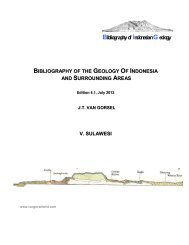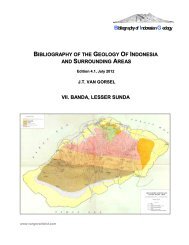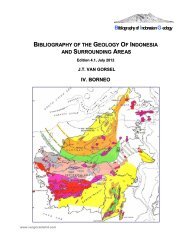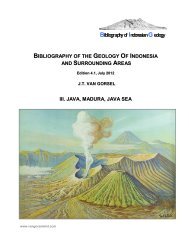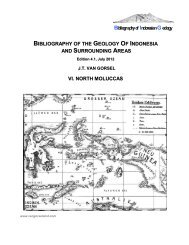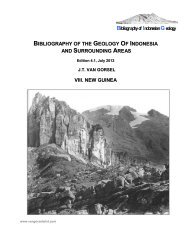Sumatra, Sunda Shelf, Natuna - Bibliography of Indonesia Geology
Sumatra, Sunda Shelf, Natuna - Bibliography of Indonesia Geology
Sumatra, Sunda Shelf, Natuna - Bibliography of Indonesia Geology
Create successful ePaper yourself
Turn your PDF publications into a flip-book with our unique Google optimized e-Paper software.
II.3. <strong>Natuna</strong><br />
The <strong>Natuna</strong> area forms the N edge <strong>of</strong> the <strong>Sunda</strong> shelf. Geologically it may be viewed as a westerly<br />
continuation <strong>of</strong> the Cretaceous active continental margin <strong>of</strong> NW Borneo with a basement <strong>of</strong><br />
metamorphic-accretionary complexes and granites.<br />
<strong>Natuna</strong> island is on the N-S trending <strong>Natuna</strong> Arch basement high, which is part <strong>of</strong> the non-extended<br />
<strong>Sunda</strong> <strong>Shelf</strong>. Its core is composed <strong>of</strong> intensely folded Jurassic- Cretaceous Bunguran Fm deep<br />
water clastics and volcanics with radiolarian cherts and gabbros-serpentinites, and is very similar to<br />
the 'Danau Fm' <strong>of</strong> C Kalimantan (Bothe 1928). It is intruded by Late Cretaceous granites, one <strong>of</strong><br />
which forms the highest mountain on the island (Mt. Tanai; 1035m). This basement complex is<br />
unconformably overlain by thin Oligocene- Miocene fluvial sediments.<br />
The <strong>Natuna</strong> islands are bordered on three sides by Oligocene rift basins, the Malay- W <strong>Natuna</strong> basin<br />
in the West, The South China Sea in the North and the E <strong>Natuna</strong> basin in the East.<br />
Most <strong>of</strong> the 80 publications on the <strong>Natuna</strong> area are on oil and gas exploration and fields in the West<br />
and East <strong>Natuna</strong> basins. The West <strong>Natuna</strong> Basin is connected to the larger Malay Basin.<br />
Exploration and production focused on Late Oligocene- Miocene fluvial-deltaic clastic reservoirs,<br />
mainly in young (~Late Miocene) inversion structures.<br />
The East <strong>Natuna</strong> basin was not affected by the young inversion tectonics. It contains large E-M<br />
Miocene reefal buildups, some <strong>of</strong> which are gas bearing, typically with high CO2 content.<br />
Suggested reading<br />
<strong>Geology</strong>: Bothe (1928), Haile (1970, 1971), Pupilli (1973), Franchino (1990),<br />
Harahap & Wiryosujono (1994), Hakim & Suryono (1994, 1997),<br />
Hakim (2004)<br />
W. <strong>Natuna</strong> Basin: Wongkosantiko & Wirojudo (1984), Daines (1985), Ginger et al. (1993),<br />
Fainstein & Meyer (1997), Phillips et al. (1997), Gunarto et al. (2000),<br />
Maynard et al. (2002), Morley et al. (2003), Hakim et al. (2008)<br />
E. <strong>Natuna</strong> Basin: Sangree (1981), Kraft & Sangree (1982), Franchino & Viotti (1986),<br />
Rudolph & Lehmann (1989), Dunn et al. (1996), Bachtel et al. (2004)<br />
,<br />
<strong>Bibliography</strong> <strong>of</strong> <strong>Indonesia</strong> <strong>Geology</strong> v. 4.1 4 www.vangorselslist.com July 2012



